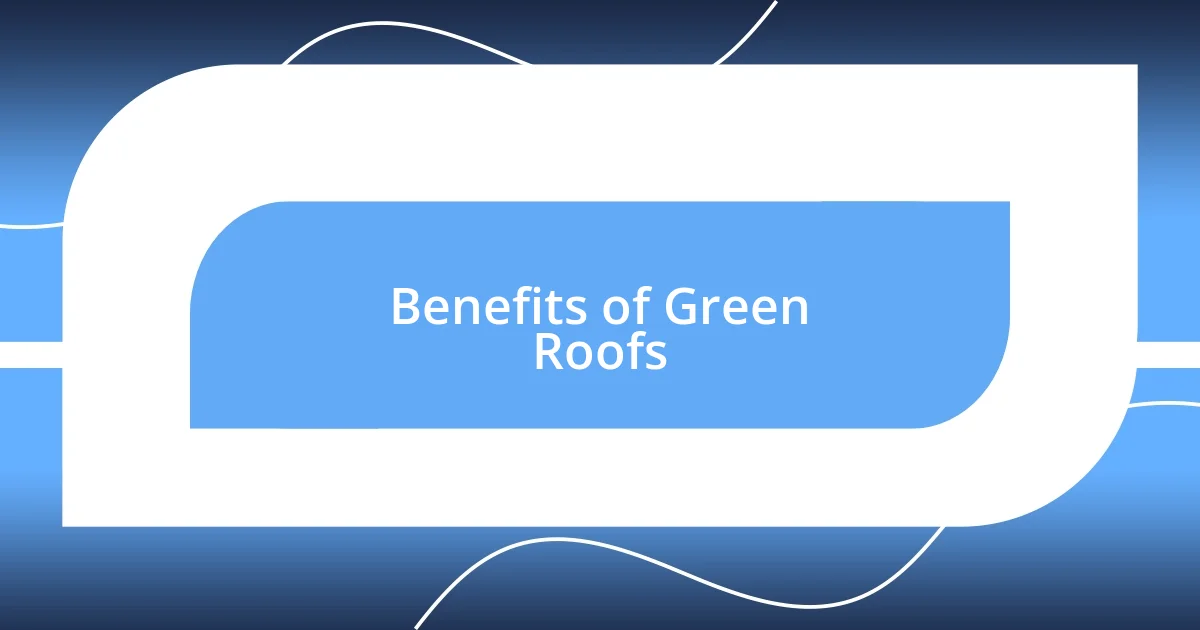Key takeaways:
- Green roofs provide numerous environmental benefits, including energy efficiency, stormwater management, improved air quality, and enhanced urban biodiversity.
- Selecting the right plants for a green roof is essential; native, drought-resistant species are recommended for their resilience and low maintenance.
- Regular maintenance, including inspections, appropriate watering, and tailored fertilization, is crucial for the health and success of a green roof ecosystem.

Introduction to Green Roofs
Green roofs have always fascinated me. They transform traditional buildings into vibrant ecosystems, providing not just a visual appeal, but also a myriad of environmental benefits. Have you ever wondered how much a simple rooftop can influence urban biodiversity?
Not long ago, I visited a community center with a stunning green roof. As I walked through the space, I felt an overwhelming sense of peace. The lush plants seemed to create a mini-haven in the concrete jungle, showing me that nature can thrive even in the most unexpected places.
The beauty of green roofs goes beyond aesthetics; they also play a crucial role in urban sustainability. They help insulate buildings, reduce energy consumption, and manage stormwater runoff. It’s incredible to think that something as simple as a layer of soil and plants can positively impact our environment, isn’t it?

Benefits of Green Roofs
The benefits of green roofs are simply astounding. I remember attending a local festival at a building topped with a green roof. The organizer mentioned how the roof helped reduce the building’s energy costs significantly. It made me realize how integral these installations are for sustainable living, all while providing a thermal barrier that keeps indoor temperatures comfortable.
Consider these advantages:
– Energy Efficiency: Green roofs help insulate buildings, leading to lower heating and cooling costs.
– Stormwater Management: They absorb rainwater, reducing runoff and lowering the risk of urban flooding.
– Air Quality Improvement: Plants filter pollutants and carbon dioxide, contributing to cleaner air.
– Biodiversity Enhancement: They create habitats for various species, promoting urban wildlife.
– Noise Reduction: Green roofs can dampen sound, making urban areas quieter.
Every time I step onto a green roof, I reconnect with nature. It reminds me of the balance we can achieve between urban living and the environment around us. For me, it’s not just about saving energy; it’s about fostering a healthier ecosystem where we all can thrive.

Selecting the Right Plants
Selecting the right plants for a green roof is crucial. I learned this firsthand while designing my own green space. The initial thrill of planting was soon overshadowed by the reality that not all plants thrive in rooftop conditions. I was surprised to discover that succulents and drought-resistant species work wonders in such environments. These plants not only withstand dry periods but also require minimal maintenance, which is a win-win for any busy urban gardener.
During my research, I created a checklist to help narrow down my plant options. I focused on native species, which adapted better to local climates. It’s remarkable how nature has its way of selecting plants that can endure extreme conditions. For instance, when I planted some native sedums, the vibrant colors lasted throughout the seasons, and they attracted pollinators like bees, enriching my rooftop ecosystem.
Here’s a simple comparison of some popular plant types for green roofs:
| Plant Type | Notes |
|---|---|
| Succulents | Drought resistant, low maintenance |
| Native Grasses | Adaptable and provides habitat |
| Flowering Perennials | Attracts pollinators and offers seasonal colors |
| Herbs | Edible, aromatic scents, and pest deterrents |

Installation Process of Green Roofs
The installation of green roofs is an exciting process, but it requires careful planning and execution. I remember standing on my rooftop, anxiously watching the crew prepare for the installation day. They first assessed the structural integrity of my building to ensure it could support the weight of the soil and plants. I found it fascinating how they carefully planned each layer, starting with a waterproof membrane to prevent leaks—a step I initially overlooked but soon realized was essential.
As the installation progressed, I became more engaged with each layer being added. They included a drainage layer, which is crucial to keep plants from drowning. I was surprised by how much focus they put on the growth medium—the soil mix had to be lightweight yet rich enough to support the plants. Watching this process unfold brought a sense of anticipation; I couldn’t help but think, “What will my green oasis look like once it’s all done?”
Finally, the moment came to plant. It’s incredible how a few small plants can transform a bare rooftop into a vibrant space. I still cherish that day—the smells of fresh soil and greenery mixed with sunlight made it feel almost magical. Did you ever think about how a roof can become a garden? For me, seeing the green roof come to life cemented my belief in the beauty and potential we can bring to urban environments.

Maintenance Tips for Green Roofs
Caring for a green roof goes beyond just planting; regular maintenance is key to keeping it healthy and thriving. I remember the first time I overlooked the importance of routine checks. After a heavy storm, I found some plants struggling because debris had clogged the drainage system. I learned that a simple monthly inspection can save you from larger issues down the line. Make it a habit to clear away leaves and check for water pooling, keeping your green oasis safe and looking its best.
Watering might seem straightforward, but I’ve discovered that it’s not one-size-fits-all. While some plants thrive on neglect, others need a bit more attention, especially during droughts. I once lost a few flowering perennials simply because I assumed they could withstand the heat without extra hydration. Now, I’ve made a point of testing the soil moisture before watering—this simple tip has made a world of difference in keeping my plants vibrant.
Fertilizing is another crucial element that can’t be ignored. I remember the first spring after my green roof was installed; I eagerly applied a general-purpose fertilizer without checking the specifics of my plant species. The result? A growth spurt that overwhelmed some of my more delicate plants. Since then, I’ve learned to research the nutrient needs for each type of plant I have. Tailoring your approach based on the specific species can help maintain balance and promote the lush greenery you envision. Have you ever noticed the difference a little extra care can make? Trust me, it’s worth the effort!

Overcoming Common Challenges
Maintaining a green roof isn’t without its hurdles, and I’ve faced a few challenging moments on my journey. One particularly unforgettable experience was when I spotted some of my favorite plants wilting due to inadequate sunlight. I hadn’t realized how the angle of the sun changed throughout the seasons, affecting my plants’ exposure. It taught me the valuable lesson of observing not just the plants but their environment too. Have you ever considered how sunlight can impact plant health on your roof?
Another challenge lies in pest management. At one point, I noticed tiny creatures munching on my greenery, which caused quite a panic! I quickly learned that using natural deterrents was safer than resorting to chemicals. I sprinkled some diatomaceous earth and introduced beneficial insects like ladybugs. It felt empowering to find organic solutions that didn’t compromise the ecosystem of my rooftop. Have you experienced a battle with pests in your garden?
Lastly, I had to navigate the intricacies of plant selection based on my rooftop’s microclimate. Initially, I picked a mix of flowering plants based solely on their beauty. However, I quickly realized that some struggled with the harsher conditions during the afternoon sun. As I replaced them with hardier, drought-resistant varieties, I couldn’t help but feel a sense of relief. The joy of watching my green roof flourish became a testament to the skill of adapting and listening to what my space truly needed. Have you ever had to make tough choices in your gardening efforts?














